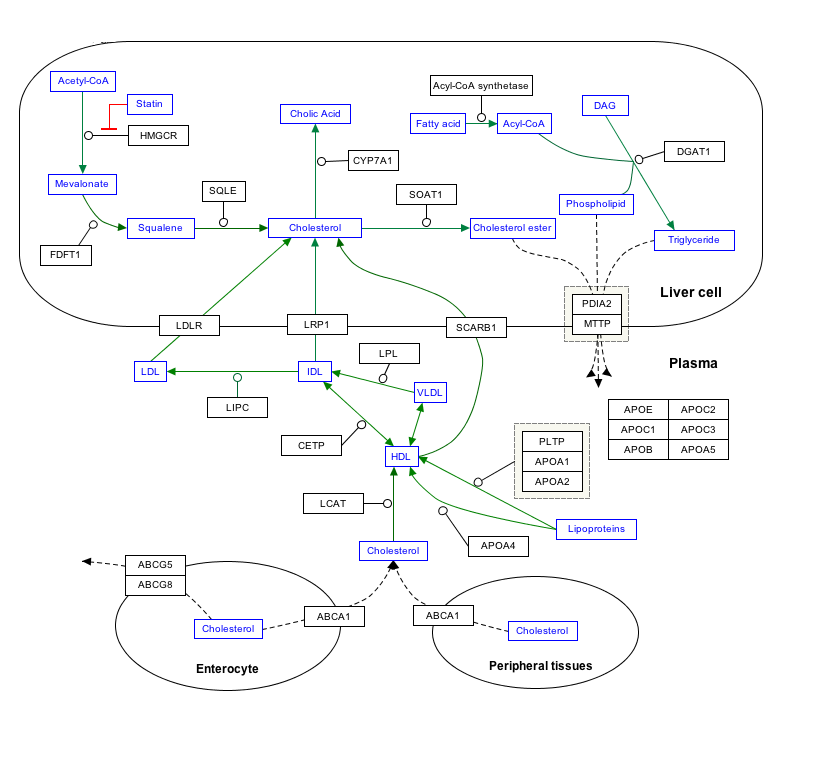Cholesterol
| Cholesterol | |
|---|---|
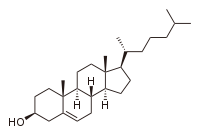 |
|
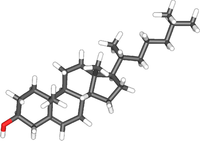 |
|
|
(3β)-cholest-5-en-3-ol
|
|
|
Other names
(10R,13R)-10,13-dimethyl-17-(6-methylheptan-2-yl)-2,3,4,7,8,9,11,12,14,15,16,17-dodecahydro-1H-cyclopenta[a]phenanthren-3-ol
|
|
| Identifiers | |
| CAS number | 57-88-5 |
| PubChem | 5997 |
| ChemSpider | 5775 |
|
SMILES
O[C@@H]4C/C3=C/C[C@@H]1[C@H](CC[C@]2([C@H]1CC[C@@H]2[C@H](C)CCCC(C)C)C)[C@@]3(C)CC4
|
|
|
InChI
InChI=1/C27H46O/c1-18(2)7-6-8-19(3)23-11-12-24-22-10-9-20-17-21(28)13-15-26(20,4)25(22)14-16-27(23,24)5/h9,18-19,21-25,28H,6-8,10-17H2,1-5H3/t19-,21+,22+,23-,24+,25+,26+,27-/m1/s1
Key: HVYWMOMLDIMFJA-DPAQBDIFBB |
|
| Properties | |
| Molecular formula | C27H46O |
| Molar mass | 386.65 g/mol |
| Appearance | white crystalline powder[1] |
| Density | 1.052 g/cm3 |
| Melting point |
148–150 °C[1] |
| Boiling point |
360 °C (decomposes) |
| Solubility in water | 0.095 mg/L (30 °C) |
| Solubility | soluble in acetone, benzene, chloroform, ethanol, ether, hexane, isopropyl myristate, methanol |
| Except where noted otherwise, data are given for materials in their standard state (at 25 °C, 100 kPa) |
|
| Infobox references | |
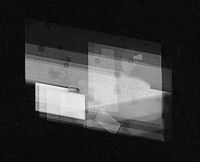
Cholesterol is a waxy steroid metabolite found in the cell membranes and transported in the blood plasma of all animals.[2] It is an essential structural component of mammalian cell membranes, where it is required to establish proper membrane permeability and fluidity. In addition, cholesterol is an important component for the manufacture of bile acids, steroid hormones, and fat-soluble vitamins including Vitamin A, Vitamin D, Vitamin E, and Vitamin K. Cholesterol is the principal sterol synthesized by animals, but small quantities are synthesized in other eukaryotes, such as plants and fungi. It is almost completely absent among prokaryotes, which include bacteria.[3] Although cholesterol is an important and necessary molecule for animals, a high level of serum cholesterol is an indicator for diseases such as heart disease.
The name cholesterol originates from the Greek chole- (bile) and stereos (solid), and the chemical suffix -ol for an alcohol, as François Poulletier de la Salle first identified cholesterol in solid form in gallstones, in 1769. However, it was only in 1815 that chemist Eugène Chevreul named the compound "cholesterine".[4]
Contents |
Physiology
Overview
Since cholesterol is essential for all animal life, it is primarily synthesized from simpler substances within the body. However, high levels in blood circulation, depending on how it is transported within lipoproteins, are strongly associated with progression of atherosclerosis. For a person of about 68 kg (150 pounds), typical total body cholesterol synthesis is about 1 g (1,000 mg) per day, and total body content is about 35 g. Typical daily additional dietary intake, in the United States is 200–300 mg . The body compensates for cholesterol intake by reducing the amount synthesized.
Cholesterol is recycled. It is excreted by the liver via the bile into the digestive tract. Typically about 50% of the excreted cholesterol is reabsorbed by the small bowel back into the bloodstream. Phytosterols can compete cholesterol reabsorption in intestinal tract back into the intestinal lumen for elimination.[5]
Function
Cholesterol is required to build and maintain membranes; it regulates membrane fluidity over the range of physiological temperatures. The hydroxyl group on cholesterol interacts with the polar head groups of the membrane phospholipids and sphingolipids, while the bulky steroid and the hydrocarbon chain are embedded in the membrane, alongside the nonpolar fatty acid chain of the other lipids. In this structural role, cholesterol reduces the permeability of the plasma membrane to protons (positive hydrogen ions) and sodium ions.[6]
Within the cell membrane, cholesterol also functions in intracellular transport, cell signaling and nerve conduction. Cholesterol is essential for the structure and function of invaginated caveolae and clathrin-coated pits, including caveola-dependent and clathrin-dependent endocytosis. The role of cholesterol in such endocytosis can be investigated by using methyl beta cyclodextrin (MβCD) to remove cholesterol from the plasma membrane. Recently, cholesterol has also been implicated in cell signaling processes, assisting in the formation of lipid rafts in the plasma membrane. In many neurons, a myelin sheath, rich in cholesterol, since it is derived from compacted layers of Schwann cell membrane, provides insulation for more efficient conduction of impulses.[7]
Within cells, cholesterol is the precursor molecule in several biochemical pathways. In the liver, cholesterol is converted to bile, which is then stored in the gallbladder. Bile contains bile salts, which solubilize fats in the digestive tract and aid in the intestinal absorption of fat molecules as well as the fat-soluble vitamins, Vitamin A, Vitamin D, Vitamin E, and Vitamin K. Cholesterol is an important precursor molecule for the synthesis of Vitamin D and the steroid hormones, including the adrenal gland hormones cortisol and aldosterone as well as the sex hormones progesterone, estrogens, and testosterone, and their derivatives.
Some research indicates that cholesterol may act as an antioxidant.[8]
Dietary sources
Animal fats are complex mixtures of triglycerides, with lesser amounts of phospholipids and cholesterol. As a consequence, all foods containing animal fat contain cholesterol to varying extents.[9] Major dietary sources of cholesterol include cheese, egg yolks, beef, pork, poultry, and shrimp.[10]
Human breast milk also contains significant quantities of cholesterol.[11]
The amount of cholesterol is present in plant-based food sources is generally much lower than animal based sources.[10][12] In addition, plant products such as flax seeds and peanuts contain cholesterol-like compounds called phytosterols, which are suggested to help lower serum cholesterol levels.[13]
Total fat intake, especially saturated fat and trans fat,[14] plays a larger role in blood cholesterol than intake of cholesterol itself. Saturated fat is present in full fat dairy products, animal fats, several types of oil and chocolate. Trans fats are typically derived from the partial hydrogenation of unsaturated fats, and, in contrast to other types of fat, do not occur in significant amounts in nature. Research supports a recommendation to minimize or eliminate trans fats from the diet due to their adverse health effects.[15] Trans fat is most often encountered in margarine and hydrogenated vegetable fat, and consequently in many fast foods, snack foods, and fried or baked goods.
A change in diet in addition to other lifestyle modifications may help reduce blood cholesterol. Avoiding animal products may decrease the cholesterol levels in the body not only by reducing the quantity of cholesterol consumed but also by reducing the levels of animal-based food consumed and the quantity of cholesterol synthesized. Those wishing to reduce their cholesterol through a change in diet should aim to consume less than 7% of their daily calories from saturated fat and less than 200 mg of cholesterol per day.[16]
The view that a change in diet (to be specific, a reduction in dietary fat and cholesterol) can lower blood cholesterol levels, and thus reduce the likelihood of development of, among others, coronary artery disease (CHD) has been challenged. An alternative view is that any reductions to dietary cholesterol intake are counteracted by the organs such as the liver, which will increase or decrease production of cholesterol to keep blood cholesterol levels constant.[17] Another view is that although saturated fat and dietary cholesterol also raise blood cholesterol, these nutrients are not as effective at doing this as is animal protein.[18]
Synthesis
About 20–25% of total daily cholesterol production occurs in the liver; other sites of high synthesis rates include the intestines, adrenal glands, and reproductive organs. Synthesis within the body starts with one molecule of acetyl CoA and one molecule of acetoacetyl-CoA, which are dehydrated to form 3-hydroxy-3-methylglutaryl CoA (HMG-CoA). This molecule is then reduced to mevalonate by the enzyme HMG-CoA reductase. This step is the regulated, rate-limiting and irreversible step in cholesterol synthesis and is the site of action for the statin drugs (HMG-CoA reductase competitive inhibitors).
Mevalonate is then converted to 3-isopentenyl pyrophosphate in three reactions that require ATP. This molecule is decarboxylated to isopentenyl pyrophosphate, which is a key metabolite for various biological reactions. Three molecules of isopentenyl pyrophosphate condense to form farnesyl pyrophosphate through the action of geranyl transferase. Two molecules of farnesyl pyrophosphate then condense to form squalene by the action of squalene synthase in the endoplasmic reticulum. Oxidosqualene cyclase then cyclizes squalene to form lanosterol. Finally, lanosterol is then converted to cholesterol.[19]
Konrad Bloch and Feodor Lynen shared the Nobel Prize in Physiology or Medicine in 1964 for their discoveries concerning the mechanism and regulation of cholesterol and fatty acid metabolism.
Regulation of cholesterol synthesis
Biosynthesis of cholesterol is directly regulated by the cholesterol levels present, though the homeostatic mechanisms involved are only partly understood. A higher intake from food leads to a net decrease in endogenous production, whereas lower intake from food has the opposite effect. The main regulatory mechanism is the sensing of intracellular cholesterol in the endoplasmic reticulum by the protein SREBP (sterol regulatory element-binding protein 1 and 2).[20] In the presence of cholesterol, SREBP is bound to two other proteins: SCAP (SREBP-cleavage-activating protein) and Insig1. When cholesterol levels fall, Insig-1 dissociates from the SREBP-SCAP complex, allowing the complex to migrate to the Golgi apparatus, where SREBP is cleaved by S1P and S2P (site-1 and -2 protease), two enzymes that are activated by SCAP when cholesterol levels are low. The cleaved SREBP then migrates to the nucleus and acts as a transcription factor to bind to the SRE (sterol regulatory element), which stimulates the transcription of many genes. Among these are the low-density lipoprotein (LDL) receptor and HMG-CoA reductase. The former scavenges circulating LDL from the bloodstream, whereas HMG-CoA reductase leads to an increase of endogenous production of cholesterol.[21] A large part of this signaling pathway was clarified by Dr. Michael S. Brown and Dr. Joseph L. Goldstein in the 1970s. In 1985, they received the Nobel Prize in Physiology or Medicine for their work. Their subsequent work shows how the SREBP pathway regulates expression of many genes that control lipid formation and metabolism and body fuel allocation.
Cholesterol synthesis can be turned off when cholesterol levels are high, as well. HMG CoA reductase contains both a cytosolic domain (responsible for its catalytic function) and a membrane domain. The membrane domain functions to sense signals for its degradation. Increasing concentrations of cholesterol (and other sterols) cause a change in this domain's oligomerization state, which makes it more susceptible to destruction by the proteosome. This enzyme's activity can also be reduced by phosphorylation by an AMP-activated protein kinase. Because this kinase is activated by AMP, which is produced when ATP is hydrolyzed, it follows that cholesterol synthesis is halted when ATP levels are low.[22]
Plasma transport and regulation of absorption
Cholesterol is only slightly soluble in water; it can dissolve and travel in the water-based bloodstream at exceedingly small concentrations. Since cholesterol is insoluble in blood, it is transported in the circulatory system within lipoproteins, complex spherical particles which have an exterior composed of amphiphilic proteins and lipids whose outward-facing surfaces are water-soluble and inward-facing surfaces are lipid-soluble; triglycerides and cholesterol esters are carried internally. Phospholipids and cholesterol, being amphipathic, are transported in the surface monolayer of the lipoprotein particle.
In addition to providing a soluble means for transporting cholesterol through the blood, lipoproteins have cell-targeting signals that direct the lipids they carry to certain tissues. For this reason, there are several types of lipoproteins within blood called, in order of increasing density, chylomicrons, very-low-density lipoprotein (VLDL), intermediate-density lipoprotein (IDL), low-density lipoprotein (LDL), and high-density lipoprotein (HDL). The more cholesterol and less protein a lipoprotein has the less dense it is. The cholesterol within all the various lipoproteins is identical, although some cholesterol is carried as the "free" alcohol and some is carried as fatty acyl esters referred to as cholesterol esters. However, the different lipoproteins contain apolipoproteins, which serve as ligands for specific receptors on cell membranes. In this way, the lipoprotein particles are molecular addresses that determine the start- and endpoints for cholesterol transport.
Chylomicrons, the least dense type of cholesterol transport molecules, contain apolipoprotein B-48, apolipoprotein C, and apolipoprotein E in their shells. Chylomicrons are the transporters that carry fats from the intestine to muscle and other tissues that need fatty acids for energy or fat production. Cholesterol which is not used by muscles remains in more cholesterol-rich chylomicron remnants, which are taken up from the bloodstream by the liver.
VLDL molecules are produced by the liver and contain excess triacylglycerol and cholesterol that is not required by the liver for synthesis of bile acids. These molecules contain apolipoprotein B100 and apolipoprotein E in their shell. During transport in the bloodstream, the blood vessels cleave and absorb more triacylglycerol to leave IDL molecules, which contain an even higher percentage of cholesterol. The IDL molecules have two possible fates: Half are taken up by the liver for metabolism into other biomolecules and the other half continue to lose triacylglycerols in the bloodstream until they form LDL molecules, which have the highest percentage of cholesterol within them.
LDL molecules, therefore, are the major carriers of cholesterol in the blood, and each one contains approximately 1,500 molecules of cholesterol ester. The shell of the LDL molecule contains just one molecule of apolipoprotein B100, which is recognized by the LDL receptor in peripheral tissues. Upon binding of apolipoprotein B100, many LDL receptors become localized in clathrin-coated pits. Both the LDL and its receptor are internalized by endocytosis to form a vesicle within the cell. The vesicle then fuses with a lysosome, which has an enzyme called lysosomal acid lipase that hydrolyzes the cholesterol esters. Now within the cell, the cholesterol can be used for membrane biosynthesis or esterified and stored within the cell, so as to not interfere with cell membranes.
Synthesis of the LDL receptor is regulated by SREBP, the same regulatory protein as was used to control synthesis of cholesterol de novo in response to cholesterol presence in the cell. When the cell has abundant cholesterol, LDL receptor synthesis is blocked so that new cholesterol in the form of LDL molecules cannot be taken up. On the converse, more LDL receptors are made when the cell is deficient in cholesterol. When this system is deregulated, many LDL molecules appear in the blood without receptors on the peripheral tissues. These LDL molecules are oxidized and taken up by macrophages, which become engorged and form foam cells. These cells often become trapped in the walls of blood vessels and contribute to artherosclerotic plaque formation. These plaques are the main causes of heart attacks, strokes, and other serious medical problems, leading to the association of so-called LDL cholesterol (actually a lipoprotein) with "bad" cholesterol.[22]
Also, HDL particles are thought to transport cholesterol back to the liver for excretion or to other tissues that use cholesterol to synthesize hormones in a process known as reverse cholesterol transport (RCT).[23] Having large numbers of large HDL particles correlates with better health outcomes.[24] In contrast, having small numbers of large HDL particles is independently associated with atheromatous disease progression within the arteries.
Metabolism, recycling and excretion
Cholesterol is oxidized by the liver into a variety of bile acids.[25] These in turn are conjugated with glycine, taurine, glucuronic acid, or sulfate. A mixture of conjugated and non-conjugated bile acids along with cholesterol itself is excreted from the liver into the bile. Approximately 95% of the bile acids are reabsorbed from the intestines and the remainder lost in the feces.[26] The excretion and reabsorption of bile acids forms the basis of the enterohepatic circulation which is essential for the digestion and absorption of dietary fats. Under certain circumstances, when more concentrated, as in the gallbladder, cholesterol crystallises and is the major constituent of most gallstones, although lecithin and bilirubin gallstones also occur less frequently.[27]
Interactive pathway map
Click on genes, proteins and metabolites below to link to respective Wikipedia articles. [28]
Clinical significance
Hypercholesterolemia
According to the lipid hypothesis, abnormal cholesterol levels (hypercholesterolemia)—that is, higher concentrations of LDL and lower concentrations of functional HDL—are strongly associated with cardiovascular disease because these promote atheroma development in arteries (atherosclerosis). This disease process leads to myocardial infarction (heart attack), stroke, and peripheral vascular disease. Since higher blood LDL, especially higher LDL particle concentrations and smaller LDL particle size, contribute to this process more than the cholesterol content of the LDL particles,[29] LDL particles are often termed "bad cholesterol" because they have been linked to atheroma formation. On the other hand, high concentrations of functional HDL, which can remove cholesterol from cells and atheroma, offer protection and are sometimes referred to as "good cholesterol". These balances are mostly genetically determined but can be changed by body build, medications, food choices, and other factors.[30]
Conditions with elevated concentrations of oxidized LDL particles, especially "small dense LDL" (sdLDL) particles, are associated with atheroma formation in the walls of arteries, a condition known as atherosclerosis, which is the principal cause of coronary heart disease and other forms of cardiovascular disease. In contrast, HDL particles (especially large HDL) have been identified as a mechanism by which cholesterol and inflammatory mediators can be removed from atheroma. Increased concentrations of HDL correlate with lower rates of atheroma progressions and even regression. A 2007 study pooling data on almost 900,000 subjects in 61 cohorts demonstrated that blood total cholesterol levels have an exponential effect on cardiovascular and total mortality, with the association more pronounced in younger subjects. Still, because cardiovascular disease is relatively rare in the younger population, the impact of high cholesterol on health is still larger in older people.[31]
Elevated levels of the lipoprotein fractions, LDL, IDL and VLDL are regarded as atherogenic (prone to cause atherosclerosis).[32] Levels of these fractions, rather than the total cholesterol level, correlate with the extent and progress of atherosclerosis. On the converse, the total cholesterol can be within normal limits, yet be made up primarily of small LDL and small HDL particles, under which conditions atheroma growth rates would still be high. In contrast, however, if LDL particle number is low (mostly large particles) and a large percentage of the HDL particles are large, then atheroma growth rates are usually low, even negative, for any given total cholesterol concentration. Recently, a post-hoc analysis of the IDEAL and the EPIC prospective studies found an association between high levels of HDL cholesterol (adjusted for apolipoprotein A-I and apolipoprotein B) and increased risk of cardiovascular disease, casting doubt on the cardioprotective role of "good cholesterol"[33]
Multiple human trials utilizing HMG-CoA reductase inhibitors, known as statins, have repeatedly confirmed that changing lipoprotein transport patterns from unhealthy to healthier patterns significantly lowers cardiovascular disease event rates, even for people with cholesterol values currently considered low for adults. As a result, people with a history of cardiovascular disease may derive benefit from statins irrespective of their cholesterol levels,[34] and in men without cardiovascular disease there is benefit from lowering abnormally high cholesterol levels ("primary prevention").[35] Primary prevention in women is practiced only by extension of the findings in studies on men,[36] since in women, none of the large statin trials has shown a reduction in overall mortality or in cardiovascular end points.[37]
The 1987 report of National Cholesterol Education Program, Adult Treatment Panels suggest the total blood cholesterol level should be: < 200 mg/dL normal blood cholesterol, 200–239 mg/dL borderline-high, > 240 mg/dL high cholesterol.[38] The American Heart Association provides a similar set of guidelines for total (fasting) blood cholesterol levels and risk for heart disease:[39]
| Level mg/dL | Level mmol/L | Interpretation |
| < 200 | < 5.0 | Desirable level corresponding to lower risk for heart disease |
| 200–240 | 5.2–6.2 | Borderline high risk |
| > 240 | > 6.2 | High risk |
However, as today's testing methods determine LDL ("bad") and HDL ("good") cholesterol separately, this simplistic view has become somewhat outdated. The desirable LDL level is considered to be less than 100 mg/dL (2.6 mmol/L)[40], although a newer target of < 70 mg/dL can be considered in higher risk individuals based on some of the above-mentioned trials. A ratio of total cholesterol to HDL—another useful measure—of far less than 5:1 is thought to be healthier. Of note, typical LDL values for children before fatty streaks begin to develop is 35 mg/dL.

Total cholesterol is defined as the sum of HDL, LDL, and VLDL. Usually, only the total, HDL, and triglycerides are measured. For cost reasons, the VLDL is usually estimated as one-fifth of the triglycerides and the LDL is estimated using the Friedewald formula (or a variant): estimated LDL = [total cholesterol] − [total HDL] − [estimated VLDL]. The estimated VLDL and LDL have more error when triglycerides are above 200 mg/dL.[41]
Given the well-recognized role of cholesterol in cardiovascular disease, it is surprising that some studies have shown an inverse correlation between cholesterol levels and mortality. A 2009 study of patients with acute coronary syndromes found an association of hypercholesterolemia with better mortality outcomes.[42]. In the Framingham Heart Study, in subjects over 50 years of age they found an 11% increase overall and 14% increase in CVD mortality per 1 mg/dL per year drop in total cholesterol levels. The researchers attributed this phenomenon to the fact that people with severe chronic diseases or cancer tend to have below-normal cholesterol levels.[43] This explanation is not supported by the Vorarlberg Health Monitoring and Promotion Programme, in which men of all ages and women over 50 with very low cholesterol were increasingly likely to die of cancer, liver diseases, and mental diseases. This result indicates that the low-cholesterol effect occurs even among younger respondents, contradicting the previous assessment among cohorts of older people that this is a proxy or marker for frailty occurring with age.[44]
A small group of scientists, united in The International Network of Cholesterol Skeptics, continues to question the link between cholesterol and atherosclerosis.[45] However, the vast majority of doctors and medical scientists accepts the link as fact.[46]
Hypocholesterolemia
Abnormally low levels of cholesterol are termed hypocholesterolemia. Research into the causes of this state is relatively limited, but some studies suggest a link with depression, cancer, and cerebral hemorrhage. In general, the low cholesterol levels seem to be a consequence of an underlying illness, rather than a cause.[31]
Cholesterol testing
It is recommended by the American Heart Association to test cholesterol every 5 years for people aged 20 years or older.[47]
A blood sample after 12-hour fasting is taken by a doctor or a home cholesterol-monitoring device to determine a lipoprotein profile. This measures total cholesterol, LDL (bad) cholesterol, HDL (good) cholesterol, and triglycerides. It is recommended to have cholesterol tested more frequently than 5 years if a person has total cholesterol of 200 mg/dL or more, or if a man over age 45 or a woman over age 50 has HDL (good) cholesterol less than 40 mg/dL, or there exist other risk factors for heart disease and stroke. To convert mg/dl to mmol/L (used in Canada and other parts of the world), divide the mg/dl number by 40.
Cholesteric liquid crystals
Some cholesterol derivatives, (among other simple cholesteric lipids) are known to generate the liquid crystalline cholesteric phase. The cholesteric phase is in fact a chiral nematic phase, and changes colour when its temperature changes. Therefore, cholesterol derivatives are commonly used in liquid crystal thermometers and temperature-sensitive paints.
See also
- Arcus senilis "Cholesterol ring" in the eyes
- Bile salts
- Diet and heart disease
- Lieberman-Burchard test to detect cholesterol
- Niemann Pick disease Type C
- Triglycerides
- Vertical Auto Profile
- oxycholesterol
Additional images
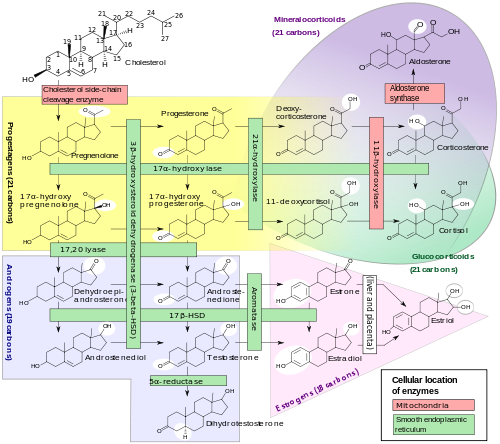 Steroidogenesis, using cholesterol as building material |
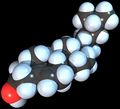 Space-filling model of the Cholesterol molecule |
 Numbering of the steroid nuclei |
References
- ↑ 1.0 1.1 "Safety (MSDS) data for cholesterol". http://physchem.ox.ac.uk/MSDS/CH/cholesterol.html. Retrieved 2007-10-20.
- ↑ Emma Leah (May 2009). "Cholesterol". Lipidomics Gateway. doi:10.1038/lipidmaps.2009.3. http://www.lipidmaps.org/update/2009/090501/full/lipidmaps.2009.3.html.
- ↑ Pearson A, Budin M, Brocks JJ (December 2003). "Phylogenetic and biochemical evidence for sterol synthesis in the bacterium Gemmata obscuriglobus". Proc. Natl. Acad. Sci. U.S.A. 100 (26): 15352–7. doi:10.1073/pnas.2536559100. PMID 14660793.
- ↑ Olson RE (February 1998). "Discovery of the lipoproteins, their role in fat transport and their significance as risk factors". J. Nutr. 128 (2 Suppl): 439S–443S. PMID 9478044. http://jn.nutrition.org/cgi/pmidlookup?view=long&pmid=9478044.
- ↑ John S, Sorokin AV, Thompson PD (February 2007). "Phytosterols and vascular disease". Curr. Opin. Lipidol. 18 (1): 35–40. doi:10.1097/MOL.0b013e328011e9e3. PMID 17218830.
- ↑ Haines TH (July 2001). "Do sterols reduce proton and sodium leaks through lipid bilayers?". Prog. Lipid Res. 40 (4): 299–324. doi:10.1016/S0163-7827(01)00009-1. PMID 11412894.
- ↑ Pawlina, Wojciech; Ross, Michael W. (2006). Histology: a text and atlas: with correlated cell and molecular biology. Philadelphia: Lippincott Wiliams & Wilkins. pp. 230. ISBN 0-7817-5056-3.
- ↑ Smith LL (1991). "Another cholesterol hypothesis: cholesterol as antioxidant". Free Radic. Biol. Med. 11 (1): 47–61. doi:10.1016/0891-5849(91)90187-8. PMID 1937129.
- ↑ Christie, William (2003). Lipid analysis: isolation, separation, identification, and structural analysis of lipids. Ayr, Scotland: Oily Press. ISBN 0-9531949-5-7.
- ↑ 10.0 10.1 "USDA National Nutrient Database for Standard Reference, Release 21" (PDF). United States Department of Agriculture. http://www.nal.usda.gov/fnic/foodcomp/Data/SR21/nutrlist/sr21w601.pdf. Retrieved 2008-10-24.
- ↑ Jensen RG, Hagerty MM, McMahon KE (1 June 1978). "Lipids of human milk and infant formulas: a review" (PDF). Am J Clin Nutr 31 (6): 990–1016. PMID 352132. http://www.ajcn.org/cgi/reprint/31/6/990.
- ↑ Behrman EJ, Gopalan V (December 2005). J. Chem. Educ. 82 (12): 1791. doi:10.1021/ed082p1791.
- ↑ Ostlund RE, Racette, SB, and Stenson WF (2003). "Inhibition of cholesterol absorption by phytosterol-replete wheat germ compared with phytosterol-depleted wheat germ". Am J Clin Nutr 77 (6): 1385–1589. PMID 12791614.
- ↑ ""Health effects of trans fatty acids" (review article)". American Journal of Clinical Nutrition 66: 1006S-1010S.
- ↑ Lopez-Garcia, E.. ""Consumption of trans-fatty acids is related to plasma biomarkers of inflammation and endothelial dysfunction"". J. Nutr. 135 (3): 562–566.
- ↑ "Dietary Guidlines for Americans 2005" (PDF). United States Department of Agriculture. http://www.health.gov/dietaryguidelines/dga2005/document/pdf/DGA2005.pdf. Retrieved 2010-07-28.
- ↑ Le Fanu, James (2000). The rise and fall of modern medicine. New York, NY: Carroll & Graf. ISBN 0-7867-0732-1.
- ↑ Campbell TC, Campbell TM (2005). The China Study: the most comprehensive study of nutrition ever conducted and the startling implications for diet, weight loss and long-term health. Benbella Books. ISBN 1-932100-38-5.
- ↑ Rhodes, Carl; Stryer, Lubert; Tasker, Roy (1995). Biochemistry (4th ed.). San Francisco: W.H. Freeman. pp. 280, 703. ISBN 0-7167-2009-4.
- ↑ Espenshade PJ, Hughes AL (2007). "Regulation of sterol synthesis in eukaryotes". Annu. Rev. Genet. 41: 401–27. doi:10.1146/annurev.genet.41.110306.130315. PMID 17666007.
- ↑ Brown MS, Goldstein JL (1997). "The SREBP pathway: regulation of cholesterol metabolism by proteolysis of a membrane-bound transcription factor". Cell 89 (3): 331. doi:10.1016/S0092-8674(00)80213-5. PMID 9150132.
- ↑ 22.0 22.1 Tymoczko, John L.; Stryer Berg Tymoczko; Stryer, Lubert; Berg, Jeremy Mark (2002). Biochemistry. San Francisco: W.H. Freeman. pp. 726–727. ISBN 0-7167-4955-6.
- ↑ Lewis GF, Rader DJ (June 2005). "New insights into the regulation of HDL metabolism and reverse cholesterol transport". Circ. Res. 96 (12): 1221–32. doi:10.1161/01.RES.0000170946.56981.5c. PMID 15976321.
- ↑ Gordon DJ, Probstfield JL, Garrison RJ, Neaton JD, Castelli WP, Knoke JD, Jacobs DR, Bangdiwala S, Tyroler HA (January 1989). "High-density lipoprotein cholesterol and cardiovascular disease. Four prospective American studies". Circulation 79 (1): 8–15. PMID 2642759.
- ↑ Javitt NB (1 December 1994). "Bile acid synthesis from cholesterol: regulatory and auxiliary pathways". FASEB J. 8 (15): 1308–11. PMID 8001744. http://www.fasebj.org/cgi/pmidlookup?view=long&pmid=8001744.
- ↑ Wolkoff AW, Cohen DE (February 2003). "Bile acid regulation of hepatic physiology: I. Hepatocyte transport of bile acids". Am. J. Physiol. Gastrointest. Liver Physiol. 284 (2): G175–9. doi:10.1152/ajpgi.00409.2002 (inactive 2009-08-18). PMID 12529265.
- ↑ Marschall HU, Einarsson C (June 2007). "Gallstone disease". J. Intern. Med. 261 (6): 529–42. doi:10.1111/j.1365-2796.2007.01783.x. PMID 17547709.
- ↑ The interactive pathway map can be edited at WikiPathways: "StatinPathway_WP430". http://www.wikipathways.org/index.php/Pathway:WP430.
- ↑ Brunzell JD, Davidson M, Furberg CD, Goldberg RB, Howard BV, Stein JH, Witztum JL (April 2008). "Lipoprotein management in patients with cardiometabolic risk: consensus statement from the American Diabetes Association and the American College of Cardiology Foundation". Diabetes Care 31 (4): 811–22. doi:10.2337/dc08-9018. PMID 18375431.
- ↑ Durrington P (August 2003). "Dyslipidaemia". Lancet 362 (9385): 717–31. doi:10.1016/S0140-6736(03)14234-1. PMID 12957096.
- ↑ 31.0 31.1 Lewington S, Whitlock G, Clarke R, Sherliker P, Emberson J, Halsey J, Qizilbash N, Peto R, Collins R (December 2007). "Blood cholesterol and vascular mortality by age, sex, and blood pressure: a meta-analysis of individual data from 61 prospective studies with 55,000 vascular deaths". Lancet 370 (9602): 1829–39. doi:10.1016/S0140-6736(07)61778-4. PMID 18061058.
- ↑ "Detection, Evaluation and Treatment of High Blood Cholesterol in Adults (Adult Treatment Panel III) Final Report" (PDF). National Institutes of Health. National Heart, Lung and Blood Institute. http://www.nhlbi.nih.gov/guidelines/cholesterol/atp3full.pdf. Retrieved 2008-10-27.
- ↑ van der Steeg WA, Holme I, Boekholdt SM, Larsen ML, Lindahl C, Stroes ES, Tikkanen MJ, Wareham NJ, Faergeman O, Olsson AG, Pedersen TR, Khaw KT, Kastelein JJ (February 2008). "High-density lipoprotein cholesterol, high-density lipoprotein particle size, and apolipoprotein A-I: significance for cardiovascular risk: the IDEAL and EPIC-Norfolk studies". J. Am. Coll. Cardiol. 51 (6): 634–42. doi:10.1016/j.jacc.2007.09.060. PMID 18261682.
- ↑ Heart Protection Study Collaborative Group (July 2002). "MRC/BHF Heart Protection Study of cholesterol lowering with simvastatin in 20,536 high-risk individuals: a randomised placebo-controlled trial". Lancet 360 (9326): 7–22. doi:10.1016/S0140-6736(02)09327-3. PMID 12114036.
- ↑ Shepherd J, Cobbe SM, Ford I, Isles CG, Lorimer AR, MacFarlane PW, McKillop JH, Packard CJ (November 1995). "Prevention of coronary heart disease with pravastatin in men with hypercholesterolemia. West of Scotland Coronary Prevention Study Group". N. Engl. J. Med. 333 (20): 1301–7. doi:0.1056/NEJM199511163332001 (inactive 2009-08-18). PMID 7566020.
- ↑ Grundy SM (May 2007). "Should women be offered cholesterol lowering drugs to prevent cardiovascular disease? Yes". BMJ 334 (7601): 982. doi:10.1136/bmj.39202.399942.AD. PMID 17494017.
- ↑ Kendrick M (May 2007). "Should women be offered cholesterol lowering drugs to prevent cardiovascular disease? No". BMJ 334 (7601): 983. doi:10.1136/bmj.39202.397488.AD. PMID 17494018.
- ↑ , (January 1988). "Report of the National Cholesterol Education Program Expert Panel on Detection, Evaluation, and Treatment of High Blood Cholesterol in Adults. The Expert Panel". Arch. Intern. Med. 148 (1): 36–69. doi:10.1001/archinte.148.1.36. PMID 3422148.
- ↑ "Cholesterol". American Heart Association. 2008-11-17. http://www.americanheart.org/cholesterol/about.jsp. Retrieved 2009-02-21.
- ↑ "About cholesterol" – American Heart Association
- ↑ Warnick GR, Knopp RH, Fitzpatrick V, Branson L (January 1990). "Estimating low-density lipoprotein cholesterol by the Friedewald equation is adequate for classifying patients on the basis of nationally recommended cutpoints". Clin. Chem. 36 (1): 15–9. PMID 2297909.
- ↑ PMID 19645040 (PubMed)
Citation will be completed automatically in a few minutes. Jump the queue or expand by hand - ↑ Anderson KM, Castelli WP, Levy D (April 1987). "Cholesterol and mortality. 30 years of follow-up from the Framingham study". JAMA 257 (16): 2176–80. doi:10.1001/jama.257.16.2176. PMID 3560398.
- ↑ Ulmer H, Kelleher C, Diem G, Concin H (2004). "Why Eve is not Adam: prospective follow-up in 149650 women and men of cholesterol and other risk factors related to cardiovascular and all-cause mortality". J Womens Health (Larchmt) 13 (1): 41–53. doi:10.1089/154099904322836447. PMID 15006277.
- ↑ Uffe Ravnskov (2000). The Cholesterol Myths : Exposing the Fallacy that Saturated Fat and Cholesterol Cause Heart Disease. New Trends Publishing, Incorporated. ISBN 0-96708-970-0.
- ↑ Daniel Steinberg (2007). The Cholesterol Wars: The Cholesterol Skeptics vs the Preponderance of Evidence. Boston: Academic Press. ISBN 0-12-373979-9.
- ↑ "How To Get Your Cholesterol Tested". American Heart Association. http://www.americanheart.org/presenter.jhtml?identifier=541. Retrieved 2009-02-21.
External links
- Detection, Evaluation, and Treatment of High Blood Cholesterol in Adults US National Institutes of Health Adult Treatment Panel III
- Aspects of fat digestion and metabolism – UN/WHO Report 1994
- American Heart Association – "About Cholesterol"
|
|||||
|
||||||||||||||||||||||||||||||||||||||||||||||||||||||||||||||||||||
|
|||||||||||||||||||||||||||||||||||||||||||||||||||||||||||||
